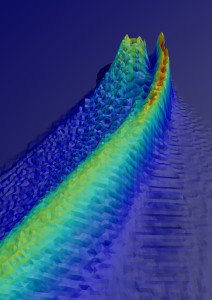The negative mass effect

FAU researchers accelerate light with a diametric drive for the first time
Physicists at FAU have proved experimentally that light pulses can accelerate each other permanently. This would allow for a controlled shift of the wavelength of light pulses, which could be interesting for many disciplines such as laser physics and spectroscopy. The scientists recently published these results in the renowned journal ‘Nature Physics’.*
Fifteen years ago, a research team at NASA thought about how to perfect spacecraft propulsion. The scientist Marc G. Millis had the rather idiosyncratic idea of using objects with a negative mass as drives. When two bodies with a positive mass gravitate towards one another, they always accelerate towards each other according to the rules of Newtonian mechanics.
The combination of objects with a positive mass and a negative mass, however, allows for an unexpected phenomenon: if a force is at work between them, both bodies begin to accelerate in the same spatial direction and become ever faster. Millis called this constellation a ‘diametric drive’. So far nobody has realised this potentially ground-breaking idea, and space travellers will most likely have to live without the revolutionary drive even in the distant future.
‘The existence of mechanical objects with a negative mass in free space violates so many of the fundamental laws of physics that it can be excluded with great certainty,’ says Prof. Dr. Ulf Peschel, professor of Experimental Physics at FAU. But only in free space: the limitations do not apply to human-made systems that are subject to their very own laws. The researchers led by Prof. Peschel used this fact to realise the optical equivalent of the diametric drive.
Together with colleagues from the Max Planck Institute for the Science of Light and from the University of Central Florida, USA, they created an optical fibre network in which specially prepared light packages behave in a manner entirely analogous to mechanical particles with a positive and a negative effective mass: if a light package with a negative effective mass is brought near another ray with a positive mass, non-linear interference results in an optical diametric drive. ‘The two light beams accelerate in the same direction and become faster and faster, exactly how you would expect it from a diametric drive,’ the optics researchers explain the experiment.
The scientists are certain that this effect can be transferred to many other physical systems. Possibly electrons in semiconductors or ultracold atoms in optical lattices could be accelerated in the same way, as the universal concept of effective mass is the basis for the drive’s functioning. Many different fields of application in optics could also benefit from the possibilities of the diametric drive such as that of changing light wavelengths using special glass fibres.
Even if spacecraft propulsion with negative mass will remain a pipe dream in the end, this science fiction-style idea from Marc G. Millis made it into reality after over 15 years and some detours. His original concept can be found here: M. G. Millis, „Challenge to Create the Space Drive“, Journal of Propulsion and Power (1997), http://www.grc.nasa.gov/WWW/bpp/1997-J_AIAA_SpaceDr.pdf
* M. Wimmer et al, „Optical diametric drive acceleration via action-reaction symmetry breaking“, in: Nature Physics. DOI: 10.1038/NPHYS2777
Further information:
Alois Regensburger
Phone: +49 (0)9131 8520343
alois.regensburger@physik.uni-erlangen.de